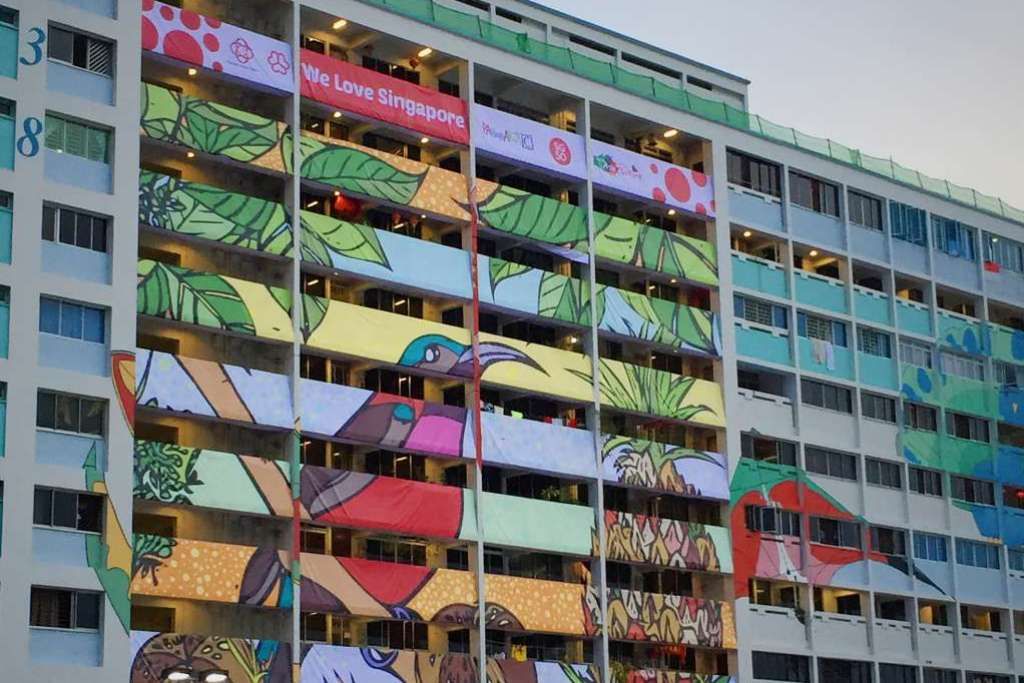Happy Golden Jubilee Singapore!

Artist and ANU Alumnus, Tan Haur, brought colour to this residential tower. Photo by The Straits Times, 8/8/2015.
Happy Birthday Singapore! Yishun residents are in high spirit presenting this eight storeys width façade art to commemorate the Singapore Golden Jubilee. A heart warming community façade art co-created by the residents and myself to celebrate Singapore’s 50th anniversary of independence! I planned it in a form of “process art” to be incorporated with mixed media and digital technology, kick start with several workshops to engage residents in observational drawing and sketching with pencil and paper. I was pleased that they had created interesting pencil line drawings as foundation for the façade art, we move on to digital processing in stage two and later apply traditional paint medium onto the digital printouts.
The entire process was exiting and engrossing, residents experienced how their key drawing elements were streamlined into graphical images via smart phone apps. With the current new media and technologies, I standardized their pencil mark making styles and strokes, montage and unite the composition with short listed digital colours and visual tension manipulation. Files were sent for inkjet output into elongated banner forms right after vector-conversion and colour management, residents carry on to complete the final artwork with weather shield pastel color paint for the backdrop doubled with polka dots.
The collaborative effort makes all staying in Singapore and Yishun proud; it represents the core value and belief of our people, living in harmony with nature, different races and religions. Here, we promote team work spirit, cohesion, enduring values that we share as Singaporeans, values that undergird the Singapore Spirit – values that have stood us in good stead in the past and give us confidence for an even brighter future.
This artwork is about the stories of Yishun in the northern part of Singapore. Yishun town has a distinctive historical background, the unique waterways that had played a major role in the history of human settlements and developments, pineapple and rubber tree plantation that boost the economy in the earlier days, and the irreplaceable kampong spirit that keeps Yishun forever so lively and attractive. I was deeply touched and inspired by the culture and peoples in this part of Singapore, a strong feeling to amplify its native habitat as a visual representation of Yishun town, a pictorial depiction of where it began and where it is heading.
(Pineapple and Rubber Tree)
Yishun is the Mandarin Romanisation of Nee Soon, named after the "pineapple king" and rubber magnate, Lim Nee Soon (b. 1879). In the old days, pineapple and rubber tree plantation was the daily sight of the residents in Yishun town; it had contributed to the major economy growth of Singapore.
(Heliconia and Sunbird)
They can be commonly sighted before Yishun turned into a massive ground of housing estate development. You are still able to spot Heliconia and Sunbird in Yishun area by paying more attention in the green zone and rural areas. Heliconia signifies the blooming life and spirit of Yishun, and the Sunbird represents freedom, goals and a balance of nature and manmade environment.
(Peoples and the Waterways)
The elongated light pastel colours backgrounds symbolize the roles and impacts of waterways in the past and now. All over the world, waterways play a major role in the history of human settlements and development. They provide water, food and a means of livelihood and transport for people who settle down around them. Likewise, the waterways here served the same purposes. In the past, these rivers were populated by river nomads known as Orang Seletar. They travelled along these waterways and the Straits of Johor, depending on the rivers for food and transport.
The first Chinese settlers here most probably arrived via these waterways. In the early 1800s, Chinese settlements formed at the foot of the rivers, most notably Seletar River. Plantations were established around these settlements. During the early days, before roads were built there, the planters would transport their produce to warehouses in town by boat down the waterways and along the eastern coast to Singapore River. While these waterways no longer serve as a means of transport and food now, they continue to play an important role in our lives. Seletar River, dammed to form Upper and Lower Seletar Reservoirs, is an important source of water for Singaporeans today.
The free flowing colored polka dots in the background symbolize our citizens and the aspiration of peoples from different races, backgrounds and religions. We are one and move as one; One People, One Nation, and One Singapore. Majulah Singapura!
~ Artist Tan Haur - Singaporean Alumnus
(Photo credit: The Straits Times Newspaper 8th AUG 2015)